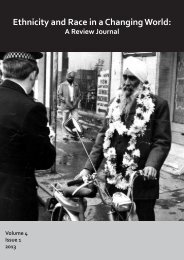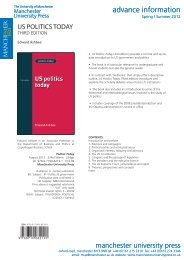Ethnicity and Race in a Changing World
Volume 2, Issue 1, 2011 - Manchester University Press
Volume 2, Issue 1, 2011 - Manchester University Press
You also want an ePaper? Increase the reach of your titles
YUMPU automatically turns print PDFs into web optimized ePapers that Google loves.
<strong>Ethnicity</strong> <strong>and</strong> <strong>Race</strong> <strong>in</strong> a Chang<strong>in</strong>g <strong>World</strong>: A Review Journalreligious artifacts were donated by <strong>in</strong>dividuals who were not themselves religious but whose deceasedrelatives had been devotees – a result, perhaps, of the revolution’s early avowedly atheistic stance <strong>and</strong>discouragement of religious practice (Grisel Fraga, <strong>in</strong>terview with author, August 2005). Casa de África,on the other h<strong>and</strong>, acquired part of Fern<strong>and</strong>o Ortiz’ personal collection after his death. While Ortiz <strong>in</strong> hislater years obta<strong>in</strong>ed religious items directly from his <strong>in</strong>formants, his collection started with items thathad been confiscated by the police when they broke up ceremonies. For a discussion of the contradictorynature of Ortiz’s ethnographic work <strong>and</strong> <strong>in</strong> particular, his beg<strong>in</strong>n<strong>in</strong>gs as a Lombrosian crim<strong>in</strong>ologist, seeBronfman, A. Measures of Equality: Social Science, <strong>Race</strong> <strong>and</strong> Citizenship <strong>in</strong> Cuba, 1902-1940. Durham:University of North Carol<strong>in</strong>a Press, 2003. The Museo Montaner de Antropologia, housed <strong>in</strong> the CalixtoGarcia Hospital, still houses a small collection of Afrocuban religious items that are a remnant of a“crim<strong>in</strong>al ethnology” exhibit that dates back to the 1930s, when medical tra<strong>in</strong><strong>in</strong>g <strong>in</strong>cluded learn<strong>in</strong>g howto recognize potentially crim<strong>in</strong>al behavior <strong>and</strong> <strong>in</strong>dividuals. The museum is only open by appo<strong>in</strong>tment, <strong>and</strong>is, accord<strong>in</strong>g to hospital staff, still occasionally used for teach<strong>in</strong>g purposes.51. This account was related to me by an audience member at a panel where I presented an early version ofthis paper, at the conference of the Association for the Study of the <strong>World</strong> African Diaspora (ASWAD), <strong>in</strong>Barbados <strong>in</strong> October 2007. The speaker identified herself as African American but I unfortunately did notnote her name.52. Alexis Esquivel Bermudez, <strong>in</strong>terview with author, June 2007. Esquivel was one of the first contemporaryCuban artists still resid<strong>in</strong>g <strong>in</strong> Cuba to offer critical perspectives on race <strong>in</strong> Cuba. In 1997, he curated acontroversial <strong>and</strong> critically acclaimed exhibit entitled “Queloide I”, (“keloid” is a medical term describ<strong>in</strong>gscar tissue; the show’s title reference to the scars slaves bore as a result of whipp<strong>in</strong>gs) followed by a showentitled “Ni Músicos Ni Deportistas” (neither musicians nor athletes). The Queloides shows (the mostrecent exhibit opened <strong>in</strong> April 2010) <strong>and</strong> Esquivel’s own artwork are discussed <strong>in</strong> Fern<strong>and</strong>es, S. (ref. 7), <strong>and</strong>De la Fuente, A. (ref. 3).53. Ortiz, F. Cuban Counterpo<strong>in</strong>t: Tobacco <strong>and</strong> Sugar. Translated by Harriet Onis. Durham, NC: DukeUniversity Press, 1995.54. It is important to specify that this discussion primarily concerns Havana’s carnival. Eastern Cuba, <strong>and</strong>particularly Santiago de Cuba, has a somewhat separate <strong>and</strong> dist<strong>in</strong>ctive carnival tradition marked by theregion’s proximity to Haiti, <strong>and</strong> other large cities have local carnivals. While Havana is the capital city <strong>and</strong>its carnival to a degree represents a “national” carnival, most Cuban scholars (<strong>and</strong> many ord<strong>in</strong>ary citizens)consider Santiago’s carnival to be more “authentic”. The critique of Havana’s carnival as too commercialdates back several decades, as noted by Rob<strong>in</strong> Moore <strong>in</strong> the one chapter he devotes to comparsas<strong>and</strong> Carnival <strong>in</strong> the early 20th century. It is also reflected <strong>in</strong> the paucity of contemporary scholarshipabout Havana carnival by either Cuban or foreign writers. The chapter on Cuba <strong>in</strong> Judith Bettelheim’sauthoritative work on Caribbean festivals focuses exclusively on Santiago’s Carnival. Another framefor explor<strong>in</strong>g the dialectic of the ethnographic <strong>and</strong> the carnivalesque is thus the relationship betweennational <strong>and</strong> local. See Nunley J. <strong>and</strong> Bettelheim, J. Caribbean Festival Arts: Each <strong>and</strong> Every Bit ofDifference. Seattle: University of Wash<strong>in</strong>gton Press, 1988. Bettelheim also edited a relevant volume - seeBettelheim, J. Cuban Festivals: A Century of Afro-Cuban Culture. Pr<strong>in</strong>ceton, NJ: Markus Wiener Publishers,2001 - her own two essays <strong>in</strong> this volume also concentrate upon Santiago.55. See Howard, Philip A. Chang<strong>in</strong>g History: Afro Cuban Cabildos <strong>and</strong> Societies of Color <strong>in</strong> the N<strong>in</strong>eteenthCentury. Baton Rouge: Louisiana State University Press, 1998. His work builds upon Fannie Rush<strong>in</strong>g’sunpublished doctoral dissertation - Rush<strong>in</strong>g, F. Cabildos de Nación, Sociedades de la Raza de Color:AfroCuban Participation <strong>in</strong> Slave Emancipation <strong>and</strong> Cuban Independence 1865-1895. University of Chicago,1992. Both Howard <strong>and</strong> Rush<strong>in</strong>g argue that the cabildos allowed blacks to both reta<strong>in</strong> cultures <strong>and</strong>identities <strong>and</strong> forge new ones. George Br<strong>and</strong>on, <strong>in</strong> Santeria from Africa to the New <strong>World</strong>: The Dead SellMemories - Br<strong>and</strong>on, G. Santeria from Africa to the New <strong>World</strong>: The Dead Sell Memories. Bloom<strong>in</strong>gton:Indiana University Press, 1997 - argues that it was <strong>in</strong> the urbanized sett<strong>in</strong>g of the cabildos that themodern religion known as santeria took shape, as free <strong>and</strong> enslaved blacks, often from different culturalbackgrounds, pieced together African religion <strong>and</strong> spiritual practices under the nom<strong>in</strong>al sponsorship ofthe Catholic Church.56. See Ferrer, A. (ref. 3)57. See Moore, R. (ref. 3)58. Felix “Pupy” Insua, Cuban folkloric performer, personal communication, September 2005 (New York City);Juan Bencomo, master drum maker, personal communication, August 2005 (Havana, Cuba).59. For further discussion of the PIC <strong>and</strong> the “war” of 1912, see (ref. 3) . The PIC rema<strong>in</strong>s a controversial23






